S=u2S(u);
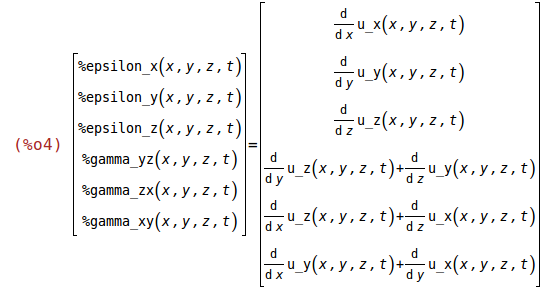
Appendix 1: AT-Cut alpha-Quartz Resonator
(See: Microsystem Design by Stephen D. Senturia, pp. 192-193, 570-577)
(See: An Introduction to the Theory of Piezoelectricity by Jiashi Yang, pp. 89-93)
1 Linear Piezoelectricity
1.1 Displacement (u), Strain (S), and Stress (T)
u: displacement [m]
(%i1)
u:matrix([u_x(x,y,z,t)],[u_y(x,y,z,t)],[u_z(x,y,z,t)])$
u2S(u):=matrix([diff(u[1,1],x)],[diff(u[2,1],y)],[diff(u[3,1],z)],[diff(u[2,1],z)+diff(u[3,1],y)],[diff(u[1,1],z)+diff(u[3,1],x)],[diff(u[1,1],y)+diff(u[2,1],x)])$
S: strain [] (%epsilon: normal strain, %gamma: shear strain)
(%i3)
S:matrix([%epsilon_x(x,y,z,t)],[%epsilon_y(x,y,z,t)],[%epsilon_z(x,y,z,t)],[%gamma_yz(x,y,z,t)],[%gamma_zx(x,y,z,t)],[%gamma_xy(x,y,z,t)])$
S=u2S(u);

(%i5)
grad(u):=matrix([diff(u[1,1],x,1),diff(u[1,1],y,1),diff(u[1,1],z,1)],[diff(u[2,1],x,1),diff(u[2,1],y,1),diff(u[2,1],z,1)],[diff(u[3,1],x,1),diff(u[3,1],y,1),diff(u[3,1],z,1)])$
grad(u);
1/2*(grad(u)+transpose(grad(u)));
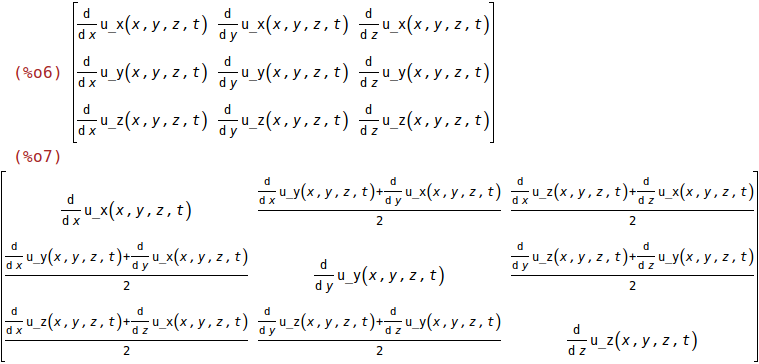
T: stress, force per unit area [N/m^2] (%sigma: normall stress, %tau: shear stress)
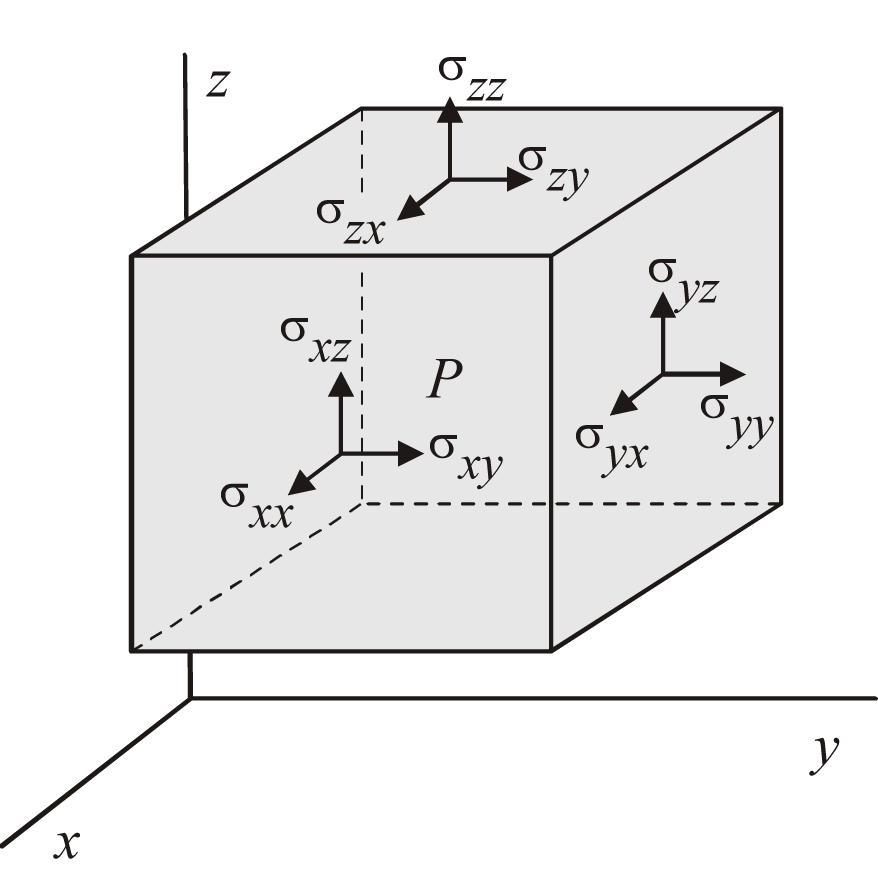
(%i8)
T:matrix([%sigma_x(x,y,z,t)],[%sigma_y(x,y,z,t)],[%sigma_z(x,y,z,t)],[%tau_yz(x,y,z,t)],[%tau_zx(x,y,z,t)],[%tau_xy(x,y,z,t)]);
divT(T):=matrix([diff(T[1,1],x,1)+diff(T[6,1],y,1)+diff(T[5,1],z,1)],[diff(T[6,1],x,1)+diff(T[2,1],y,1)+diff(T[4,1],z,1)],[diff(T[5,1],x,1)+diff(T[4,1],y,1)+diff(T[3,1],z,1)])$
divT(T);
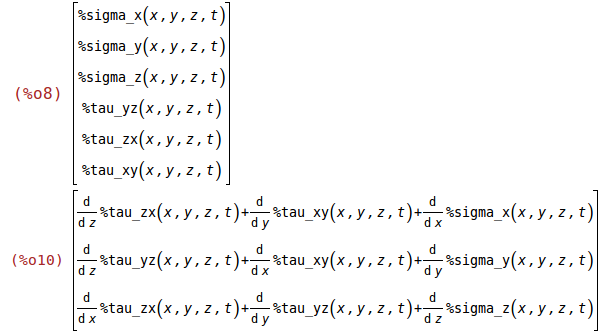
1.2 Electric Displacement (D) and Electric Field (E)
D: electric displacement [C/m^2]
(%i11)
D:matrix([D_x(x,y,z,t)],[D_y(x,y,z,t)],[D_z(x,y,z,t)]);
divD(D):=matrix([diff(D[1,1],x,1)],[diff(D[2,1],y,1)],[diff(D[3,1],z,1)])$
divD(D);
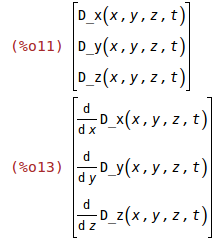
E: electric field [V/m]
(%i14)
E:matrix([E_x(x,y,z,t)],[E_y(x,y,z,t)],[E_z(x,y,z,t)]);

1.3 Linear Constitutive Tensors
The number of independent non-zero constants depends on the crystal symmetry. Y-cut (AT-, BT-, ST-cut) alpha-quartz is a material of crystal class 32.
%epsilon: dielectric permittivity tensor [C/(V.m)] (at constant strain)
(%i15)
declare([%epsilon_0,%epsilon_11,%epsilon_22,%epsilon_23,%epsilon_32,%epsilon_33],[constant,real,scalar])$
%epsilon:matrix([%epsilon_11,0,0],[0,%epsilon_22,%epsilon_23],[0,%epsilon_32,%epsilon_33]);

C: elastic stiffness tensor [N/m^2] (at constant electric field)
(%i17)
declare([C_11,C_12,C_13,C_14,C_22,C_23,C_24,C_33,C_34,C_44,C_55,C_56,C_66],[constant,real,scalar])$
C:matrix([C_11, C_12, C_13, C_14, 0, 0],[C_12, C_22, C_23, C_24, 0, 0],[C_13, C_23, C_33, C_34, 0, 0],[C_14, C_24, C_34, C_44, 0, 0],[0, 0, 0, 0, C_55, C_56],[0, 0, 0, 0, C_56, C_66]);
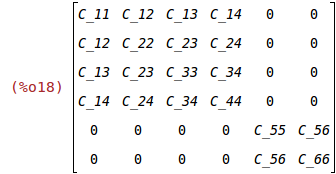
e: piezoelectricity tensor [C/m^2]
(%i19)
declare([e_11,e_12,e_13,e_14,e_25,e_26,e_35,e_36],[constant,real,scalar])$
e:matrix([e_11,e_12,e_13,e_14,0,0],[0,0,0,0,e_25,e_26],[0,0,0,0,e_35,e_36]);

1.4 Lippmann's Linear Constitutive Equations in Charge-Stress Form
(%i21)
T:C.S-transpose(e).E;
D:e.S+transpose(%epsilon).E;

Some of the most important resonator phenomena (e.g. acceleration sensitivity) are due to nonlinear effects. Quartz has numerous higher order constants, e.g., 14 third-order and 23 fourth-order elastic constants, as well as 16 third-order piezoelectric coefficients are known (Source: "Quartz Crystal Resonators and Oscillators for Frequency Control and Timing Applications - A Tutorial", by John R. Vig, November 2008.)
2 Boundary Value Problem
Assume a thickness-shear vibration of a AT-cut quartz plate around the Z-axis, excited by an electric field along the Y-axis.
Assume the plate can not move along the Y- and Z-axis: u_y(y,t)=0, u_z(y,t)=0.
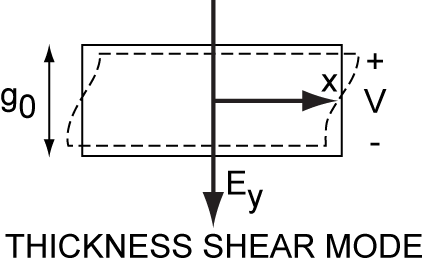
(%i23)
%epsilon_x(x,y,z,t):=0$
%epsilon_y(x,y,z,t):=0$
%epsilon_z(x,y,z,t):=0$
%gamma_yz(x,y,z,t):=0$
%gamma_xz(x,y,z,t):=0$
%gamma_xy(x,y,z,t):=diff(u_x(y,t),y,1)$
Assume the X- and Z-component of the electric field to be zero: E_x(x,y,z,t)=0, E_z(x,y,z,t)=0.
(%i29)
E:matrix([0],[E_y(y,t)],[0]);
T:ev(C.S-transpose(e).E);
D:ev(e.S+transpose(%epsilon).E);
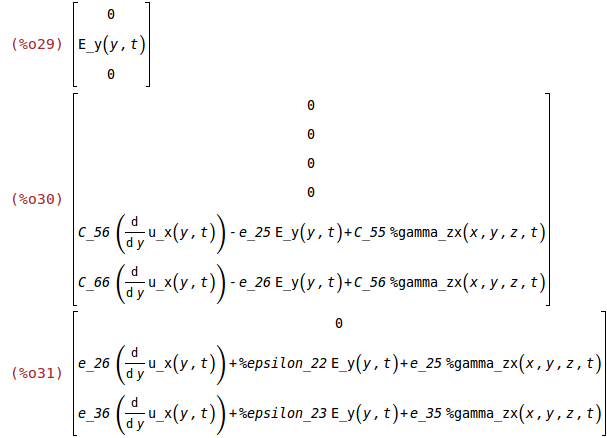
2.1 Potential Energy
Electrostatic Energy Density, w_e
(%i32)
w_e:expand(ev(1/2*transpose(E).D));

Elastic Energy Density, w_m
(%i33)
w_m:expand(ev(1/2*transpose(S).C.S));

Total Energy Density
(%i34)
w_t:w_e+w_m;

2.2 Newton's Law of Motion for a Continuum [PDE in Quartz Volume]
Force density
(%i35)
ev(T);
f:ratsimp(divT(ev(T)));
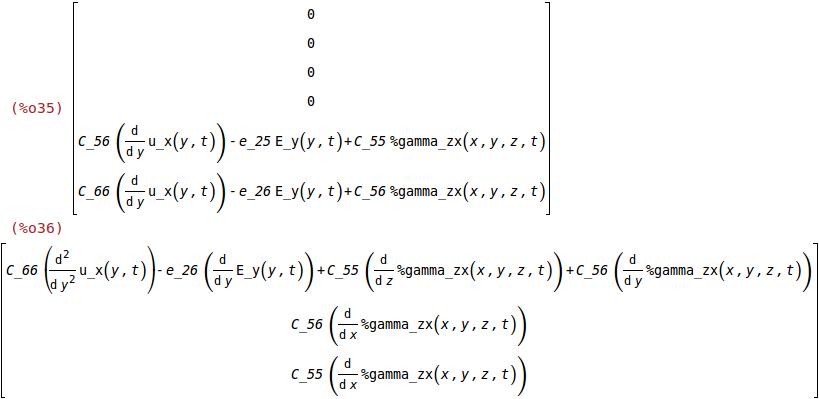
Viscosity and Q Factor
%eta: viscosity tensor [N/(m^2.s)]
%tau_m is the motional time constant
%omega_m is the mechanical resonant radian frequency
Q_m is the mechanical Q factor
(%i37)
%tau_m:1/(%omega_m*Q_m);
%eta:%tau_m*C;
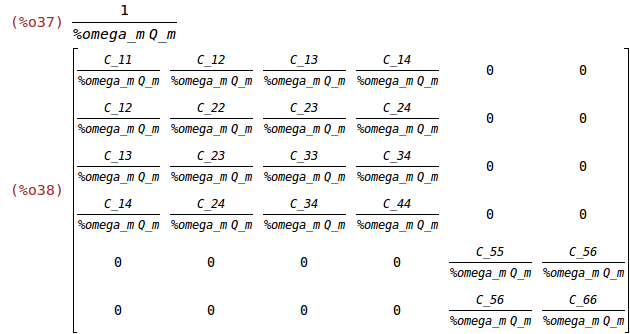
Newton's Equation of Motion
%rho: mass density [kg/m^3]
(%i39)
f=%rho*diff(u,t,2);
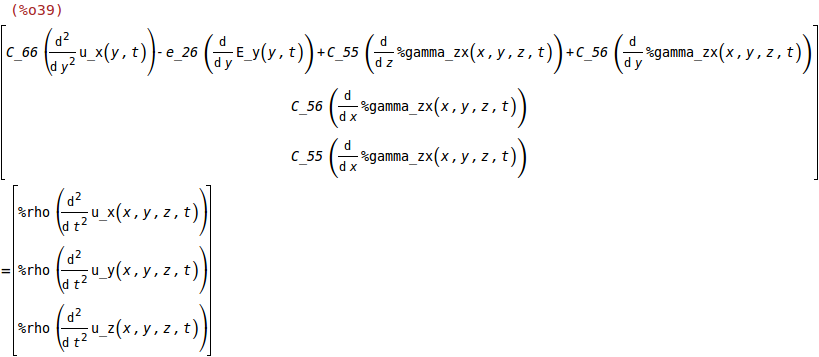
(%i40)
f_x:ev(f[1,1]);
f_x=%rho*diff(u_x(y,t),t,2);

3 Gauss' Law [PDE in Quartz Volume]
(%i42)
divD(ev(D))=matrix([0],[0],[0]);

Calculating 'diff(E_y(y,t),y,1)
(%i43)
-(e_26*('diff(u_x(y,t),y,2)))/%epsilon_22;

Calculating E_y(y,t)
B_1 is an integration constant.
(%i44)
declare([B_1],[constant,real,scalar])$
define(E_y(y,t),-(e_26*(diff(u_x(y,t),y,1)))/%epsilon_22-B_1);

4 Boundary Conditions
Assume a solution u_x(y,t):=A_1*sin(%xi*y)*exp(%i*%omega_m*t) with %xi:sqrt(%rho/(C_66*(1+k_26^2)))*%omega
k_26: sqrt(e_26^2/(%epsilon_22*C_66))
(%i46)
declare([A_1],[constant,real,scalar])$
u_x(y):=A_1*sin(%xi*y);
ratsimp(diff(u_x(y),y,1));
ratsimp(diff(u_x(y),y,2));

(%i50)
define(T_xy(y),C_66*(1+k_26^2)*%th(2)+e_26*B_1);
D_y(y):=-%epsilon_22*B_1;
define(E_y(y),-(e_26*%th(4))/%epsilon_22-B_1);
define(f_x(y),C_66*(1+k_26^2)*%th(4));
define(f_s_z(z),C_66*%th(5));
define(f_p_z(z),-e_26*(diff(E_z(z),z,1)));
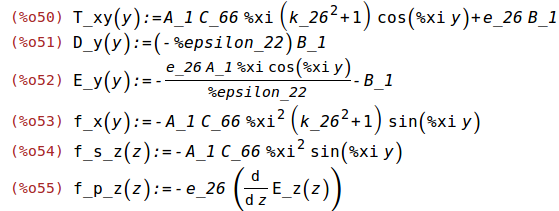
Calculating the potential %Phi(y)
B_2 is an integration constant.
(%i56)
declare([B_2],[constant,real,scalar])$
%Phi(y):=e_26*u_x(y)/%epsilon_22+B_1*y+B_2;

%tau_xy(z=-g_0/2)=0,
%tau_xy(z=g_0/2)=0,
%Phi(z=g_0/2)-%Phi(z=-g_0/2)=V,
with,
g_0: thickness [m]
V: applied voltage [V]
(%i58)
solve([ev(T_xy(g_0/2))=0,ev(%Phi(g_0/2)-%Phi(-g_0/2))=V(t)],[A_1,B_1])$
A_1:ratsimp(ev(A_1,%));
B_1:ratsimp(ev(B_1,%th(2)));
ratsimp(ev(A_1,%xi=%pi/g_0));
ratsimp(ev(B_1,%xi=%pi/g_0));
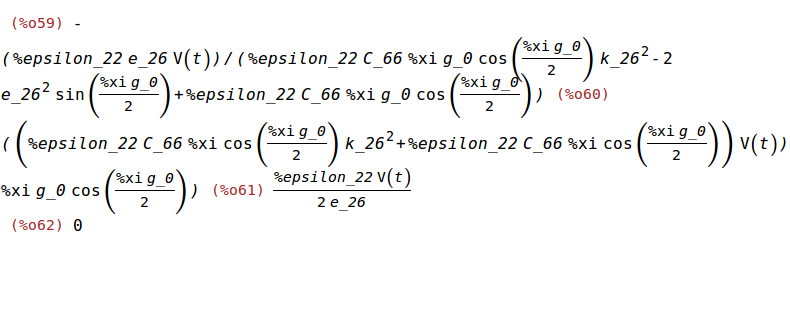
5 Elastic Wave Equation and Christoffel Equation
(See: http://sepwww.stanford.edu/public/docs/sep92/hector1/paper_html/node2.html)
(%i63)
K:ev(1/k*matrix([k_x,0,0,0,k_z,k_y],[0,k_y,0,k_z,0,k_x],[0,0,k_z,k_y,k_x,0]),k_x=0,k_z=0);
k:ev(sqrt(k_x^2+k_y^2+k_z^2),k_x=0,k_z=0);
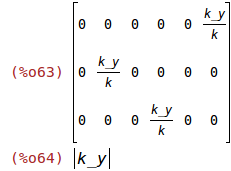
(%i65)
M:ratsimp(k^2/%rho*K.subst(C_66*(1+k_26^2),C_66,C).transpose(K));
ratsimp(eigenvalues(M));
ratsimp(eigenvectors(M));
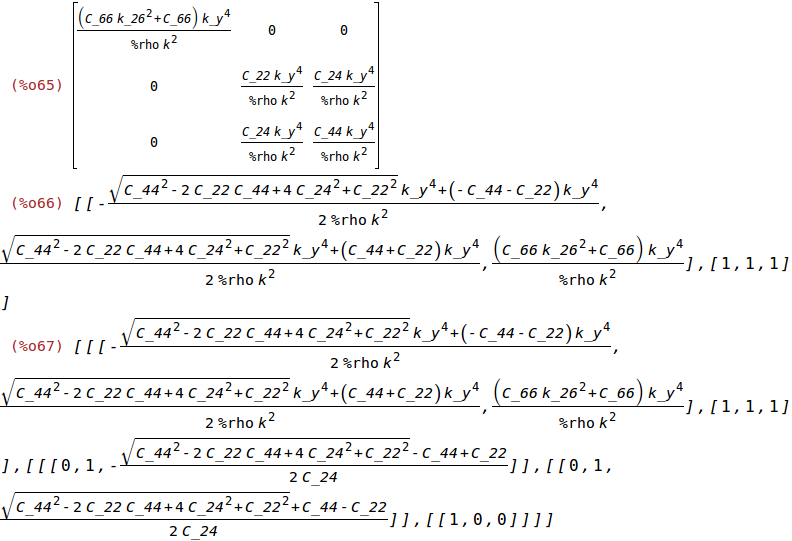
The vibration frequency of the thickness-shear mode, f_m, can be used to determine the thickness of the Y-cut alpha-quartz plate, g_0
(%i68)
declare([%rho,C_66,g_0,k_26],[constant,real,scalar])$
assume(%rho>0)$
assume(C_66>0)$
assume(g_0>0)$
assume(k_26>0)$
k_y:2*%pi/(2*g_0);
%omega_m:sqrt(ev((k_y^2*C_66*(1+k_26^2))/(%rho)));
f_m:1/(2*%pi)*%omega_m;
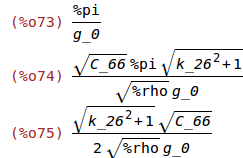
m is the effective mass.
A is the electrode area.
(%i76)
declare([A],[constant,real,scalar])$
m:A*integrate(u_x(y)^2*%rho,y,0,g_0/2)/A_1^2$
m:ev(m,%xi=sqrt(%rho/(C_66*(1+k_26^2)))*%omega_m);

k_1_eff is the linear spring constant.
(%i79)
solve([%omega_m=sqrt(k_1_eff/m)],[k_1_eff])$
ev(k_1_eff,%);

Tf is the linear temperature coefficient of frequency.
(%i81)
Tf:'diff(log(f_m),Temp);

6 Charge, q, on the Electrodes
Boundary condition for D
A is the electrode area.
(%i82)
q:ratsimp(-D_y(g_0/2)*A);

7 Motional Capacitance, C_m, Static Capacitance, C_0, and Transduction Factor, %eta
(%i83)
C_XTAL:ev(q/V,
%xi=sqrt(%rho/(C_66*(1+e_26^2/(%epsilon_22*C_66))))*%omega,
k_26=sqrt(e_26^2/(%epsilon_22*C_66)));
C_0:ratsimp(limit(C_XTAL,%omega,0));
ratsimp(C_XTAL-C_0)$
C_m:ratsimp(ev(k_26^2*C_0,
k_26=sqrt(e_26^2/(%epsilon_22*C_66))));
%eta:ratsimp(ev(sqrt(k_26^2*k_1_eff*C_0),
k_26=sqrt(e_26^2/(%epsilon_22*C_66))));
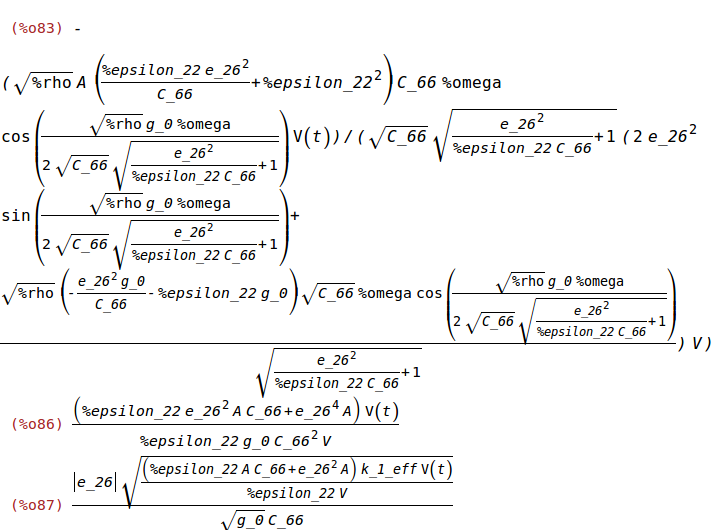
8 Material Parameters
8.1 AT-Cut alpha-Quartz (Trigonal Structure, Crystal Class 32)
(See "Elastic and Piezoelectric Constants of Alpha-Quartz", by R. Bechmann, American Physical Society Phys. Rev., vol. 110, no. 5, pp. 1060-1061, June 1958)
(%i88)
C_11:86.74;
C_12:-8.25;
C_13:27.15;
C_14:-3.66;
C_22:129.77;
C_23:-7.42;
C_24:5.70;
C_33:102.83;
C_34:9.92;
C_44:38.61;
C_55:68.81;
C_56:2.53;
C_66:29.01;
C:1e9*matrix([C_11, C_12, C_13, C_14, 0, 0],[C_12, C_22, C_23, C_24, 0, 0],[C_13, C_23, C_33, C_34, 0, 0],[C_14, C_24, C_34, C_44, 0, 0],[0, 0, 0, 0, C_55, C_56],[0, 0, 0, 0, C_56, C_66]);
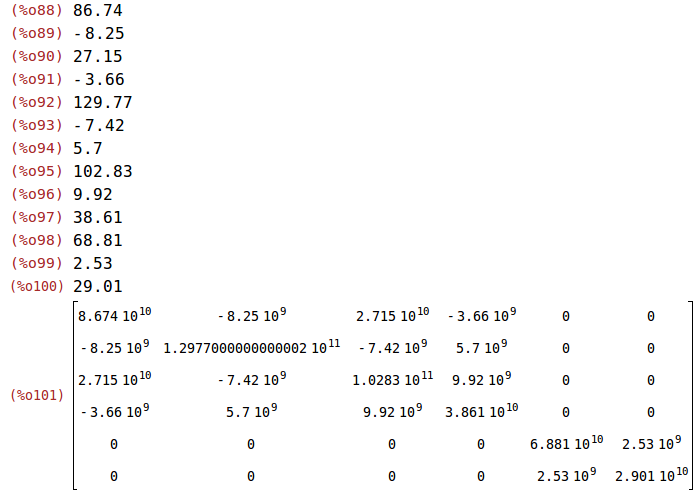
(%i102)
e_11:0.171;
e_12:-0.152;
e_13:-0.0187;
e_14:0.067;
e_25:0.108;
e_26:-0.095;
e_35:-0.0761;
e_36:0.067;
e:matrix([e_11,e_12,e_13,e_14,0,0],[0,0,0,0,e_25,e_26],[0,0,0,0,e_35,e_36]);
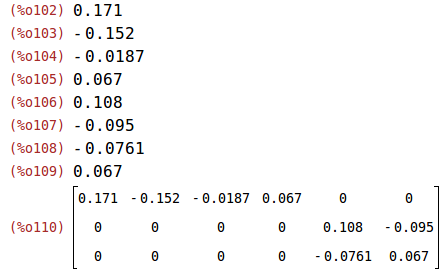
(%i111)
%epsilon_11:39.21;
%epsilon_22:39.82;
%epsilon_23:0.86;
%epsilon_32:0.86;
%epsilon_33:40.42;
%epsilon:1e-12*matrix([%epsilon_11,0,0],[0,%epsilon_22,%epsilon_23],[0,%epsilon_32,%epsilon_33]);
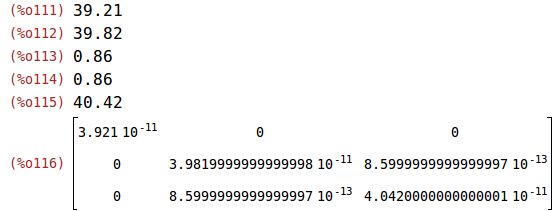
(%i117)
%rho:2650.67;

k: piezoelectric coupling coefficient
(%i118)
k_26:sqrt(e_26^2/(C_66*1e9*%epsilon_22*1e-12));
k_26^2;
